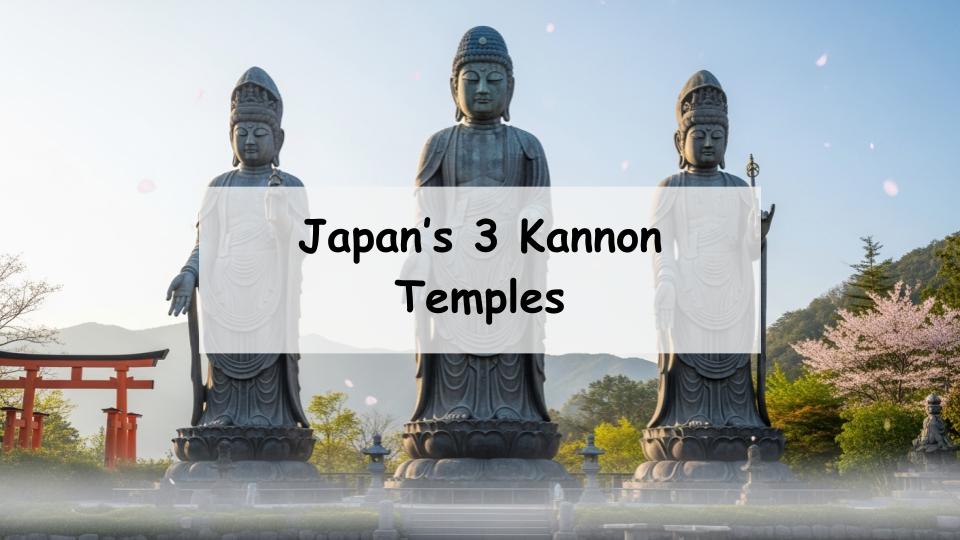Are you wondering, “Where exactly are Japan’s Three Great Kannon Temples?” or “Why were these three chosen in the first place?” If so, you’re not alone. Many people are curious about the background and significance of these iconic temples.
In short, the “Three Great Kannon Temples of Japan” refer to three especially revered Buddhist temples dedicated to Kannon (the Goddess of Mercy). Known for their deep-rooted history, spiritual value, and cultural significance, these temples have become major pilgrimage and tourist destinations.
This article will explain the exact locations of the Three Great Kannon Temples, the reasons they were selected, and the unique historical and spiritual appeal of each. If you’re interested in starting a temple pilgrimage or are simply looking for your next meaningful travel destination, this guide will help you take the first step.
- Where Are Japan’s Three Great Kannon Temples? Basic Overview and Definition
- Locations and Characteristics of the Three Great Kannon Temples
- 3 Reasons These Temples Are So Appealing
- How to Enjoy Your Visit to the Three Great Kannon Temples
- Conclusion: Deepening Faith and Travel Through the Three Great Kannon Temples
Where Are Japan’s Three Great Kannon Temples? Basic Overview and Definition
What Are the “Three Great Kannon Temples”?
The term “Three Great Kannon Temples of Japan” refers to three sacred sites that have been deeply revered for centuries. While the title isn’t officially designated by the government, it is widely accepted through cultural tradition. The three temples most commonly referred to are: Asakusa Kannon (Senso-ji) in Tokyo, Osu Kannon in Nagoya, and Tsu Kannon in Mie Prefecture.
Why Were These Three Selected?
These temples have long histories and have attracted enormous followings since the Edo period. Their central locations in major cities and their integration into the everyday lives of locals helped establish their prominence. The consistent flow of pilgrims and the temples’ cultural roles contributed to their status as the “Three Great Kannon.”
How Are They Different from Other Famous Temples?
While many temples across Japan are dedicated to Kannon, these three stand out for their urban accessibility, historical depth, and widespread recognition. They are seen as spiritual landmarks closely tied to daily life and travel culture in Japan.
Locations and Characteristics of the Three Great Kannon Temples
Asakusa Kannon (Tokyo)
History and Highlights
Located in Tokyo’s Asakusa district, Senso-ji is Tokyo’s oldest temple, believed to have been founded in 628. Legend has it that fishermen discovered a Kannon statue in their net, which led to the temple’s establishment. With landmarks like the Kaminarimon Gate and Nakamise Shopping Street, it’s a must-see site for visitors.
Blessings and How to Visit
The temple is known for blessings related to safety, prosperity, and good health. Visitors typically purify themselves at the chozuya (water basin), offer prayers at the main hall, and wave incense smoke over themselves for healing and protection.
Osu Kannon (Nagoya)
Historical and Cultural Significance
Originally established in Gifu Prefecture, Osu Kannon was moved to central Nagoya under orders from Tokugawa Ieyasu. The temple is home to many valuable cultural assets, including rare texts such as the Kojiki (Japan’s oldest historical chronicle).
Community Connection and Events
Located near a bustling shopping district, Osu Kannon is a hub of both spiritual and social activity. Monthly markets and local festivals add to the lively atmosphere, blending devotion with community culture.
Tsu Kannon (Mie)
Origins and Local Devotion
Tsu Kannon in Mie Prefecture is believed to have been founded during the Nara period, making it one of Japan’s oldest Kannon temples. Historically, it was a common stop for travelers on their way to the Ise Grand Shrine.
Statue and Local Attractions
The main Kannon statue is a hidden Buddhist icon, only shown to the public on special occasions. Tsu City also offers historical streets and delicious local cuisine, making it a pleasant destination for both worship and sightseeing.
3 Reasons These Temples Are So Appealing
Historical Significance and Spiritual Depth
All three temples boast centuries of history and serve as spiritual centers for millions of followers. Their long-standing presence provides a deep sense of comfort and connection to Japan’s religious past.
Architectural Beauty and Cultural Value
Each temple features classic Japanese architecture and artistic treasures. From temple gates to Buddhist statues, these structures offer insight into traditional craftsmanship and religious symbolism.
Enjoyment Through Tourism and Pilgrimage
Their urban locations make them easily accessible for casual visitors and serious pilgrims alike. Visitors can enjoy local food, festivals, and cultural experiences in addition to their spiritual journey.
How to Enjoy Your Visit to the Three Great Kannon Temples
Basic Etiquette for Worship
Before entering the main hall, purify your hands and mouth at the water basin. Offer a small coin, bow, and pray silently. Many visitors also collect incense smoke over their heads and bodies, believing it brings healing and good luck.
Access and Suggested Routes
- Senso-ji is easily reached via Tokyo Metro Ginza Line or Toei Asakusa Line.
- Osu Kannon is accessible from the Nagoya City Subway Tsurumai Line.
- Tsu Kannon is about a 10-minute walk from JR or Kintetsu Tsu Station.
A two-to-three-day itinerary covering all three temples is possible by train and makes for a fulfilling spiritual tour.
Recommended Pilgrimage Gear
Bringing a goshuincho (temple stamp book) allows you to collect unique stamps from each temple. Comfortable walking shoes, seasonal attire, and a respectful attitude are all you’ll need to make the most of your journey.
Conclusion: Deepening Faith and Travel Through the Three Great Kannon Temples
Why Visiting These Temples Is Worth It
More than just sightseeing spots, these temples are windows into Japan’s spiritual heritage. Each visit connects you with centuries of faith, culture, and community, offering a meaningful experience for the soul.
Discover Your Next Spiritual Destination
Once you’ve visited the Three Great Kannon Temples, you may be inspired to explore more sacred sites across Japan. Your journey can become not just a trip, but a deeper exploration of belief, tradition, and self.









Comment